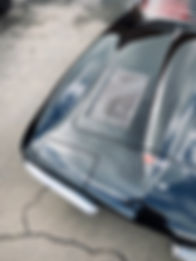

PAINT CORRECTION

What is Paint Correction?
Paint correction is a "fancy" term for the process commonly known as polishing. It includes the meticulous and skillful technique of correcting or minimizing surface imperfections (i.e., swirl marks, spider-webbing, micro-marring, scratches, bird dropping etching, hologram/buffer marks) on the paintwork of a vehicle. Paint correction requires advanced skills, experience, and the use of proper equipment and materials, and if performed correctly, results in a smooth, mirror-like finish.
The paint correction process is best performed by a trained specialist and is accomplished by using a machine polisher and a combination of cleansers, polishes, and/or compounds, as needed. Done professionally, the removal of these imperfections is perfectly safe and will not cause damage to a vehicle’s finish. Any marring or scratches removed will be permanent, so long as the vehicle is properly maintained and new imperfections are not introduced onto the surface.
Is Paint Correction necessary
on a new vehicle?
Paint correction is often necessary on a new vehicle, depending on the condition of the paint. New vehicles can accumulate minor imperfections, swirl marks, light surface scratching or other defects during transport from the manufacturer and handling at the dealership. Therefore, some level of correction is almost always beneficial and will enhance the overall appearance and ensure a flawless finish.
After paint correction, paint protection film and/or ceramic coating are highly recommended to protect and encapsulate the newly corrected finish.
Has your vehicle lost its original luster since you first bought it?
Whether your vehicle has seen a few too many automated car washes, unfortunate parking lot mishaps, or just has regular wear and tear from the years, paint correction may be the perfect solution to restore your vehicle's beauty. Using only the highest quality products and tools, we are able to remove and refine paint marring, etchings, swirls and defects, bringing out your paints true depth and clarity.
We offer three levels of correction:
-
Level 1: Approximately 50-70% defect removal
-
Level 2: Approximately 70-80% defect removal
-
Level 3: Approximately 90% or greater defect removal
Following one of these paint correction levels, the application of one of our paint protection film and/or ceramic coating options becomes essential to encapsulate and protect the newly corrected finish.
Our Paint Correction Process

1
Wash & Decontamination
We carefully prepare each vehicle with our signature exterior hand wash and decontamination service (iron remover and clay bar treatment).
The wash shampoo is applied to all the vehicle's surfaces using a foam canon to help safely remove dirt and contamination without harming or introducing new scratches to the finish. We then gently agitate the exterior surfaces with a high-grade microfiber wash mitt, which helps further protect the vehicle’s finish. The vehicle is rinsed using our PURCLEAN™ Lot Master Spot Free Rinse System, clay barred, re-rinsed, and touchless air-dried.
2
Paint Inspection &
Test Spotting
After the wash and decontamination process, the vehicle is brought into our dedicated detailing department. We setup Scangrip® inspection lights to illuminate the vehicle's surfaces to help evaluate the paint and reveal imperfections that could go unseen. When necessary and to ensure complete protection of the paint, we measure the thickness using a special paint thickness gauge.
Our goal is to achieve the best results, while maintaining the integrity of the paint. Whether it's a Level 1 paint correction or a Level 3, it is important to understand how the paint is going to respond. You never want to dive into the most aggressive approach, so test spotting is essential to determine the correct method.
3
Polishing
We start with the finest grade of polish, gradually working up to coarser grades of polish as required to achieve just the right level of correction. We then work back down to the finest grade of polish to refine the paint’s finish.
Once we are completed with the polishing process, we wipe down each panel with a pH balanced cleaner to remove any residue from the polish and re-wash to remove any polishing dust, leaving the paint perfectly clean and ready for the protection process.





